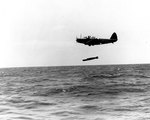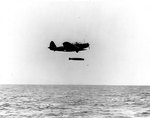Mark XIII Torpedo
| Country of Origin | United States |
| Type | Torpedo |
| Diameter | 571.500 mm |
| Length | 4.191 m |
| Ammunition Weight | 1005.00 kg |
| Range | 3.657 km |
| Machinery | Wet-heater steam turbine |
| Explosive Charge | 603 lbs. TNT or 606 lbs. TPX or 600 lbs. HBX |
| Speed | 62.00 km/h |
Contributor: David Stubblebine
ww2dbaseDesign work on the Mark XIII aerial torpedo began in 1925 but progressed in sputters and spurts because of the fluctuating attitudes of Navy planners toward the use of aerial torpedoes. So strong were the feelings that aerial torpedoes had been replaced by dive-bombing that the United States' first purpose-built aircraft carrier, USS Ranger, was designed without any torpedo storage spaces or torpedo elevators. When the thinking about aerial torpedoes swung the other way, design work and testing resumed and the Mark XIII was accepted by the Navy in 1938.Initial performance was unreliable, however, with fewer than one-third of the torpedoes performing acceptably. The design also required a drop from about 50 feet at 110 knots making the delivery aircraft extremely vulnerable to enemy fire. Modifications to the torpedo continued but the United States waged much of WWII without a dependable aerial torpedo. Most of the bugs were worked out by 1944 with the Mark XIII, Model 10. Fitted with a wooden shroud ring on the tail and a plywood drag ring on the nose, the Model 10 could be dropped effectively from 2,400 feet at 410 knots, though these extremes were not recommended. The Model 10 made it into full front-line service by the fall of 1944 and from that time onward, they received consistently favorable ratings from the torpedo squadrons in the western Pacific.
Although designed and intended strictly as an aerial torpedo, the Mark XIII was also used on certain modified PT Boats. As an aerial torpedo, PT Boats could launch the Mark XIII by simply dropping it over the side. This allowed the boats to remove their heavy torpedo tubes and replace that weight with more machine gun and cannon mounts. The Mark XIII could not be used on any class of submarine, however, because the aerial torpedo's diameter was larger than submarine torpedo tubes.
By the end of the war, dependability and performance had improved so much that the US Navy considered the Mark XIII to be the best aerial torpedo of the war and it remained in service until 1951. The Mark XIII torpedo was last used during the Korean War on 1 May 1951 when they were launched against the sluice gates at the Hwachon Dam on the Pukhan River.
In total, 16,600 examples were built.
Sources:
US Navy
Naval Weapons and Technology
Wikipedia
The Pacific War Online Encyclopedia ww2dbase
Last Major Revision: Oct 2015
Mark XIII Torpedo Interactive Map
Photographs
 |  |  |  |
Please consider supporting us on Patreon. Even $1 per month will go a long way! Thank you. Please help us spread the word: Stay updated with WW2DB: |
Search WW2DB

News
- » US State Lawmaker John Winter Caught Using Racial Slur "Jap" and Apologized (11 Jun 2025)
- » Köln/Cologne Evacuated After Discovery of WW2 Bombs (4 Jun 2025)
- » US Women's Army Corps "Six Triple Eight" Awarded with Congressional Gold Medal (30 Apr 2025)
- » Race, Holocaust, and African-American WW2 Histories Removed from the US Naval Academy Library (7 Apr 2025)
- » US Government Plans to Purge WW2 Information (17 Mar 2025)
- » See all news
Current Site Statistics
- » 1,176 biographies
- » 337 events
- » 44,933 timeline entries
- » 1,245 ships
- » 350 aircraft models
- » 207 vehicle models
- » 376 weapon models
- » 123 historical documents
- » 261 facilities
- » 470 book reviews
- » 28,471 photos
- » 365 maps
Famous WW2 Quote
"I have returned. By the grace of Almighty God, our forces stand again on Philippine soil."General Douglas MacArthur at Leyte, 17 Oct 1944
Support Us
Please consider supporting us on Patreon. Even $1 a month will go a long way. Thank you!
Or, please support us by purchasing some WW2DB merchandise at TeeSpring, Thank you!